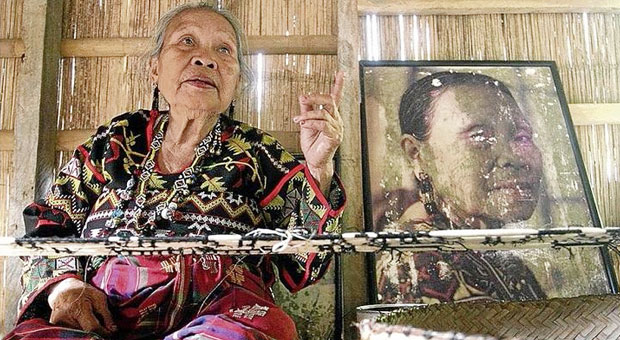KORONADAL CITY – The country lost a national treasure after the acknowledged master of T’nalak weaving died on Thursday, about two months after she suffered a stroke, officials said.
Ninety-one year-old and T’boli Lang Dulay, who received the “National Treasures-Gawad ng Manlilikha ng Bayan” award given by the National Commission for Culture and the Arts (NCCA), “has quietly joined her Creator in her ancestral home in Lake Sebu, South Cotabato,” Lake Sebu Mayor Antonio Fungan said in a statement Friday.
Known as “The Dreamweaver,” Dulay developed and mastered the now famous and beautiful T’nalak cloth of South Cotabato’s T’boli tribe, Fungan said.
Two months ago, Dulay suffered a mild stroke and has not recovered since then. “She was bedridden until she breathed her last, she quietly went away,” Fungan said.
In recognition of her contribution to the preservation of Philippine culture, then President Fidel V. Ramos bestowed on her in 1998 the “Gawad Manlilikha Award ng Bayan.”
Maricris Jan Tobias wrote in an article posted on the NCCA website that Dulay shed tears of joy when informed she was one of the “Gawad ng Manlilikha ng Bayan” awardees.
Tobias said Dulay really desired and wanted to build a school where the women in her community could go and learn to perfect the art of T’nalak making.
“Dulay knows a hundred designs, including the ‘bulinglangit’ (clouds), the ‘bankiring’ (hair bangs), and the ‘kabangi’ (butterfly), each one special for the stories it tells. Using red and black dyes, she spins her stories with grace. Her textiles reflect the wisdom and the visions of her people,” Tobias wrote.
“Ironically, modern designs get a better price than the traditional ones. Despite this, and that fact that those modern designs are easier to weave, Lang persists in doing things the old, if harder, way, to give voice, in effect to the songs that were her elders’ before her,” Tobias added.
Fungan said the legacy left by Dulay will continue in South Cotabato as she already transferred her T’nalak weaving expertise to her children, her grandchildren and even to neighbors and the T’boli tribe.
“The famous T’nalak weaving will continue as a tribute to Lang Dulay,” the mayor said.
Carlo Ebeo, NCCA vice chair of committee on cultural education, said Dulay’s demise was a “great loss” to the country but added that “she left a living legacy that will forever be part of our heritage.”
Ebeo said the NCCA has extended financial assistance to Dulay after she suffered mild stroke early this year.
He said the NCCA will shoulder the funeral expenses for Dulay. Relatives are still finalizing the burial details for the country’s lone “Dreamweaver.”
Dulay earned the moniker “The Dreamweaver” because, according to T’boli elders, she first made the T’nalak cloth after she dreamed about it at age 12.
The NCCA said her art was excellent because of the “fine and even quality of the yarn. “The close interweaving of the warp and weft, the traditional forms and patterns, the chromatic integrity of the dye, and the consistency of the finish,” the NCCA noted.
Nelly Dillera, Department of Tourism 12 regional director, said the region was mourning the demise of a national artist.
“Her contribution has brought T’boli and their crafts to the world, admired and produced into various fashion and house accessories. Her Weaving Center that served as an area where she taught younger generation about the art and skill of weaving has been frequented by media, designers and tourists worldwide,” Dillera said.
Dillera said she was suggesting that a “Tourism Road” will be constructed, leading to Dulay’s place and the weaving center. It should be named the ‘Lang Dulay Road,’ she said.
